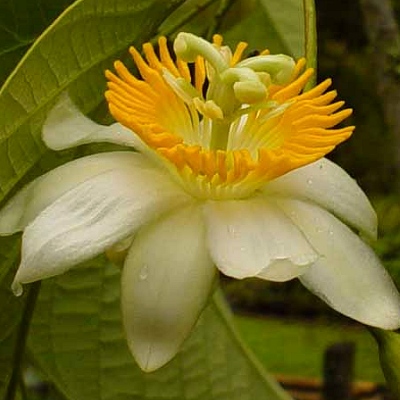"Tree Passionflower"
Germinating the seeds
When to plant -- Plant them when you receive them for best results. Getting started -- Start by sterilizing your seeds by soaking them for 10 minutes in a mix of 1 part bleach to 10 parts water. Then soak for 8-12 hours in a cup of plain water. If you have germinated other Passiflora species before, you may use the same technique that worked for you. Soil -- Use a soil that holds moisture well but that also drains well. A typical mix is 2 parts potting soil to 1 part perlite or coarse horticultural sand. An alternate mix is equal parts of coir fiber and perlite, with some slow-release fertilizer mixed in. Pot size - You may use small pots about 3 or 4 inches tall (7-10 cm) and 2 to 3 inches (5-8 cm) wide. The pots need drainage holes. Fill the pots with the soil mix and add water until evenly moist (but not soggy). Place a seed on top in each pot, and cover with about 1/4 inch (7 mm) of soil. Moisten the top soil layer. Until the seeds sprout, ensure that the surface soil doesn't dry out. If you place the pots in a plastic container or bag to maintain moisture, leave it open slightly to allow some fresh air to enter. Temperature -- Aim to keep them between 68 and 82° F (20-28°C) most of the time. Avoid letting them get above 86° F (30°C) or below 68° F (20°C) for more than a few hours a day. I recommend placing a minimum/maximum thermometer near the pots. Keep them in a bright spot out of direct sun. They may take anywhere from 1 to 3 months to sprout. Lighting the seedlings -- Once your seeds sprout, move them to a bright spot, with protection from afternoon sun. You may use a fluorescent light kept a few inches (10 cm) away while your plants are young. Watering: Once the seedlings are 3 weeks old, you may allow the surface soil to dry out, but aim to keep the rest of the soil evenly moist most of the time. Never let it dry out completely, but also don't keep it constantly soggy. If your water supply is very high in minerals (= "hard water"), you may need to use bottled water or rainwater. Growing on... Climate -- The plant comes from 1400-2200 meter elevation, where the climate is mild to warm all year, and nights are cooler but frost-free. I have no information on whether it can handle frost. The plant might go dormant if exposed to temperatures below 40° F (4°C). Since it comes from cloud forests, it appreciates partial sunlight. Some protection from strong afternoon sun may be necessary. Over about 50% humidity is recommended. Feeding -- Feed about every 2 months with a slow release (pelleted or organic) fertilizer. Repotting -- Once your seedlings are at least 3 inches tall (7 cm), you may repot them to larger containers about 1 quart (1 liter) in size. Repot gently and avoid letting the soil ball break apart, which can damage the roots. Water the soil before repotting to keep the soil together. For the first week after repotting, shade from sun and give no liquid fertilizer. Repot again after 4 to 6 months. The final pot size depends on how large you choose to let it grow. You may prune your plant short if necessary, or grow it horizontally like an espalier. If you have any questions or problems, please contact me. Have fun growing them! - Jeff Strange Wonderful Things
|
|||||||||


